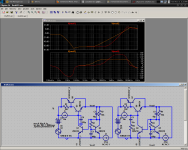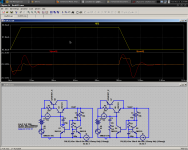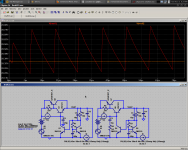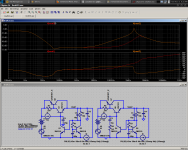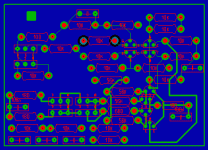Would it be an advantage if the input pairs of transistors were positioned facing each other (Flat face to flat face) to make it easy to bond the pairs together for better thermal tracking?
You can see this on the unpotted goldmund module pics on the other thread.....
A small point maybe but better sorted now than later!
You can see this on the unpotted goldmund module pics on the other thread.....
A small point maybe but better sorted now than later!
Unfortunately the pot won't work unless we only use one pair of outputs.
Chickens, one could use 4 pots and trim himself to death.

Hey Jacco, did NP ever finish matching those 1000's of Jfets? IIRC, he was going to parallel them all for a power amp...
- keantoken
- keantoken
Still at it, i gathered from a pm, i'm hoping it will go on display at next year's Burning Cramp.
(btw, you're very likely not as butch-er as moi at your current age, but you're one impressive dude)
(btw, you're very likely not as butch-er as moi at your current age, but you're one impressive dude)
Last edited:
I'm sure there are people who knew more than I do at the same age, but several decades ago. They must have ascended to mars in their spacecraft by now. It is helpful to know there's always a bigger fish.
I've been experimenting with series reg designs of late similar to the shunt. I discovered a prime example of what I'm talking about with stability into high-Q loads. Here we see two methods of compensation. The second makes a slower reg, but more reliable and stable AFAIK, especially into capacitive loads. Notice phase does not exceed 90 degrees. The first is traditional Miller style, which strives for 180deg Zout turn. HF impedance is smaller, until 20MHz, where we discover that Physics has not been fooled. Stability is traded for HF impedance.
What does the simulator mean beyond 10MHz? I dunno, but I prefer to look anyways.
- keantoken
I've been experimenting with series reg designs of late similar to the shunt. I discovered a prime example of what I'm talking about with stability into high-Q loads. Here we see two methods of compensation. The second makes a slower reg, but more reliable and stable AFAIK, especially into capacitive loads. Notice phase does not exceed 90 degrees. The first is traditional Miller style, which strives for 180deg Zout turn. HF impedance is smaller, until 20MHz, where we discover that Physics has not been fooled. Stability is traded for HF impedance.
What does the simulator mean beyond 10MHz? I dunno, but I prefer to look anyways.
- keantoken
Attachments
And finally, to conclude this three episode program, a demonstration of instability.
In a disturbing plot twist (foreshadowed in episode 2) the AC plots lie once again - this time in a terminal leap to the dark side. Plot 1 has the bigger spike, yet why does the other circuit motorboat instead?
At this point we realize Circuit 1 has in fact been telling the truth all the time... It has a naturally inductive Zout, not superficial like Number 2. While 1 forms a natural, expected resonance with the output capacitor, 2 in its terminal struggle for perfection, fails to see the obvious - perfection is impossible!
- keantoken
In a disturbing plot twist (foreshadowed in episode 2) the AC plots lie once again - this time in a terminal leap to the dark side. Plot 1 has the bigger spike, yet why does the other circuit motorboat instead?
At this point we realize Circuit 1 has in fact been telling the truth all the time... It has a naturally inductive Zout, not superficial like Number 2. While 1 forms a natural, expected resonance with the output capacitor, 2 in its terminal struggle for perfection, fails to see the obvious - perfection is impossible!
- keantoken
Attachments
My impression is that FAA is making a board of his own to test with. We can still make our own board.
- keantoken
If the group like my layout i will definitely share it of course. Just let me know how you want the layout be done and i'll update/change it..
thanks
Last edited:
Kean is doing most of the work right now, and at the moment boss, so...
FAA, I thought you were just having fun
but you are putting stress on Kean now
what you do now is a bit rude, cutting in on his work this way
or maybe its just thoughtless
or maybe you havent been around from the beginning
I think you should step back a bit
If you want to offer your help, please wait until its time
And I dont think Kean is ready just yet
so, patience, please
FAA, I thought you were just having fun
but you are putting stress on Kean now
what you do now is a bit rude, cutting in on his work this way
or maybe its just thoughtless
or maybe you havent been around from the beginning
I think you should step back a bit
If you want to offer your help, please wait until its time
And I dont think Kean is ready just yet
so, patience, please
well, it is still Kean's exclusive right to be in on the board layout, as well as other members
but not until Kean says so
thats only fair
but not until Kean says so
thats only fair
Hi Tinitus, opps sorry i didnt mean to rush/pressure kean.
As far as physical results go on design...Kean seems to be at the helm and director. NEW for him in this case with sooo many watching. He seeks perfection and wants to let NO person down. Kean seems to have WAY too much second guessing going on but if I were him here under the eyes of God and everyone, perhaps I would not do so well in my 40+ years.
I'm just watching on the sidelines here on these two associated threads and if I was doing a research paper on...I don't even know what, I'd say DIY AUDIO is turning a new page how the world will work in the future. Kean tapped it earlier in two or three of his own posts. With his own perception. No quotes provided, you've read it already and if you didn't, go back and read the entire thread from the beginning.
More coaching from every direction will not hurt Kean, he is too strong now. Those with true veteran prowess should step in and support the future of audio engineering and internet developement shared projects.
My only comment to try and help this type of evolution, is that Kean keep his Iron hot and continue to combine analytical data with measured and listened.
Questions: Has young Kean established a benchmark set of speakers to listen to amplifiers? Has Kean selected his favourite tracks to measure such sonics to rank others? If not, who cares...he will in time.
DIY AUDIO evolution at its best? I don't think I've seen anything like this here in the past 6 years(despite my posted membership tenure) I've been hanging here much longer than that.
In the old days the fights/differences seemed to stall good work(many a thread here have dead ends) but here we see new types of emergence. It seems to ME a better protocol is coming to life.
When negative comments are made, that is a good time for supporters to pull out the rest. PULL the desire from the person that is willing to evolve...but to evolve in black and white text, FFT of simulation, etched circuit board exposing only finger tips of designer...wow! Isn't it amazing?
I hope that sits well with all of yee and hopefully I will get over this mushroom buze in the AM. 😱 😎🙂
Last edited:
Mosfets:
You have said a mouth full.
I could not agree with you more. THIS Amp should be a very very good one. It has many fathers and uncles.
Kean is on his game, I for one want and will help him as much as I can lending as much of the wisdom there is in me, gained over a FEW years in the game.
Lets keep our heads and thoughts TOGETHER and this is the future for SURE.
While others are losing their heads and money else where let us gain the true SYNERGY that this thread has offered and WILL offer.
Thanks to ALL
And to the one that understands it, Salamat PO, I am working on one too.
You have said a mouth full.
I could not agree with you more. THIS Amp should be a very very good one. It has many fathers and uncles.
Kean is on his game, I for one want and will help him as much as I can lending as much of the wisdom there is in me, gained over a FEW years in the game.
Lets keep our heads and thoughts TOGETHER and this is the future for SURE.
While others are losing their heads and money else where let us gain the true SYNERGY that this thread has offered and WILL offer.
Thanks to ALL
And to the one that understands it, Salamat PO, I am working on one too.
THIS Amp should be a very very good one. It has many fathers and uncles.
The original isn't that bad either, just favorable to mix with loudspeakers that do not wander off the path of virtue too much. Which happens to apply to quite a few Frenchies, by chance.
ascended to mars in their spacecraft
Beats me, i did simulation classes at polytech (not even allowed to push the autorouting button), the wired types at the electronics faculty didn't look that fishy back then.
Well, the Asian electronic exchange stu chicks did, actually, but those went through a rough ascent screening back home, before take-off to Cheese planet, gems only.
Then again, that was decades ago, during my meat-beating neanderthal era, and i appear to have travelled back in time since.

Sheet, where am i ?
Last edited:
Mosfets:
You have said a mouth full.
I for one want and will help him as much as I can lending as much of the wisdom there is in me
 Jah Bless!
Jah Bless! Kean makes me want to move back to Texas!
jacco vermeulen;2360037
Sheet, where am i ?
I thought it was late here but Jacco isnt it like 4~5AMish there? What time do ship builders/amp builders go 2 sleep over there? 🙂
For those who will ask the question
THE answer is
Invert Physically
bend the legs over
insert both after joining thermally
THE answer is
Invert Physically
bend the legs over
insert both after joining thermally
2 sleep
Typing an additional appeal answer, courtroom show deadline.
Life sucks, and i'll be washed up in 4 hours from now

(other than that, i used to beat up folks at night, for cash, so nothing ever really changes)
I dont know much about regulators.....but to me in my mind it makes sense to have a fairly slow series regulator followed by a speedy shunt placed close to the audio circuits...the series regulator providing an over voltage and the shunt taking it down to the desired lower ripple free value...
or am I missing the point...??
or am I missing the point...??
Last edited:
- Home
- Amplifiers
- Solid State
- Goldmund Mods, Improvements, Stability
